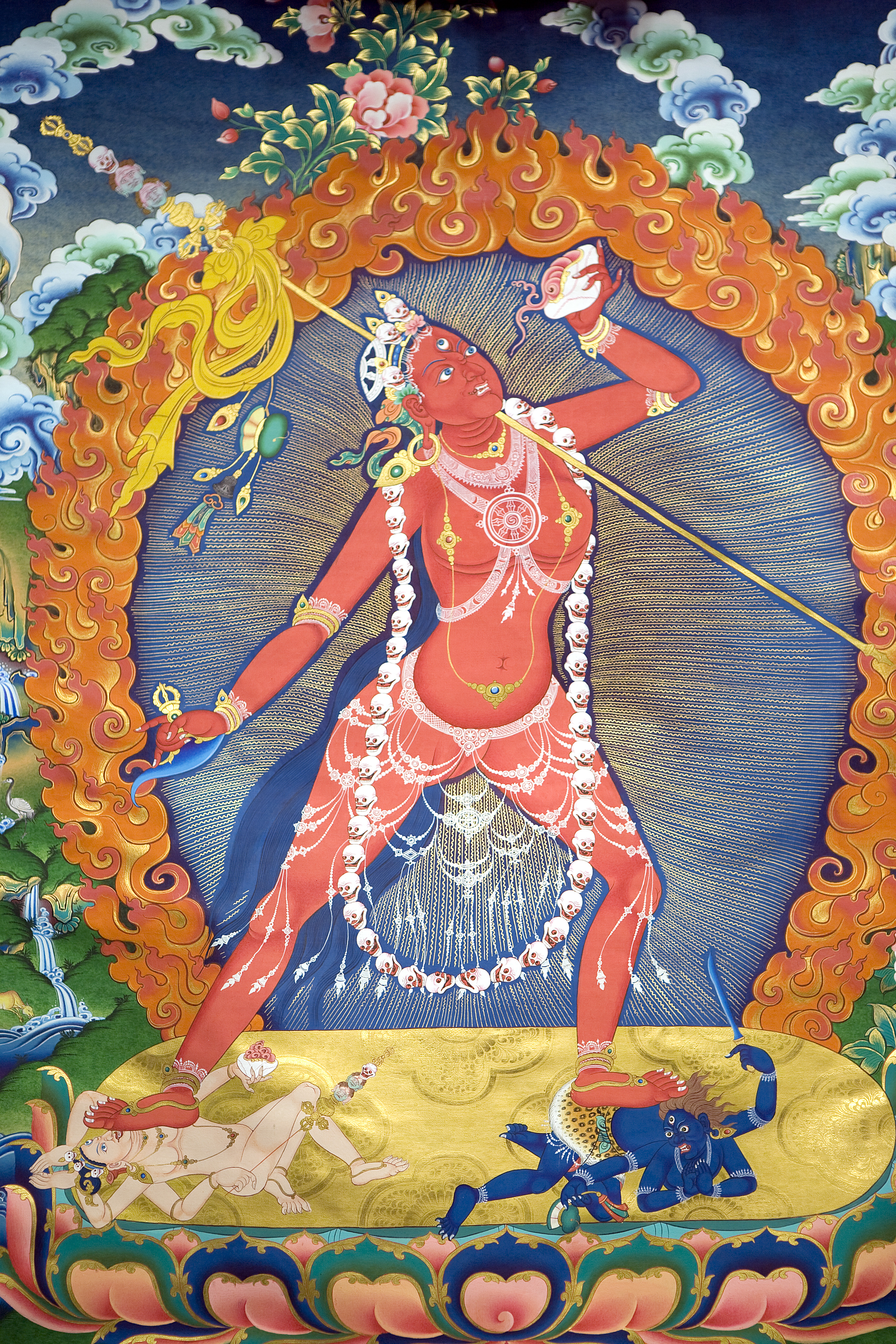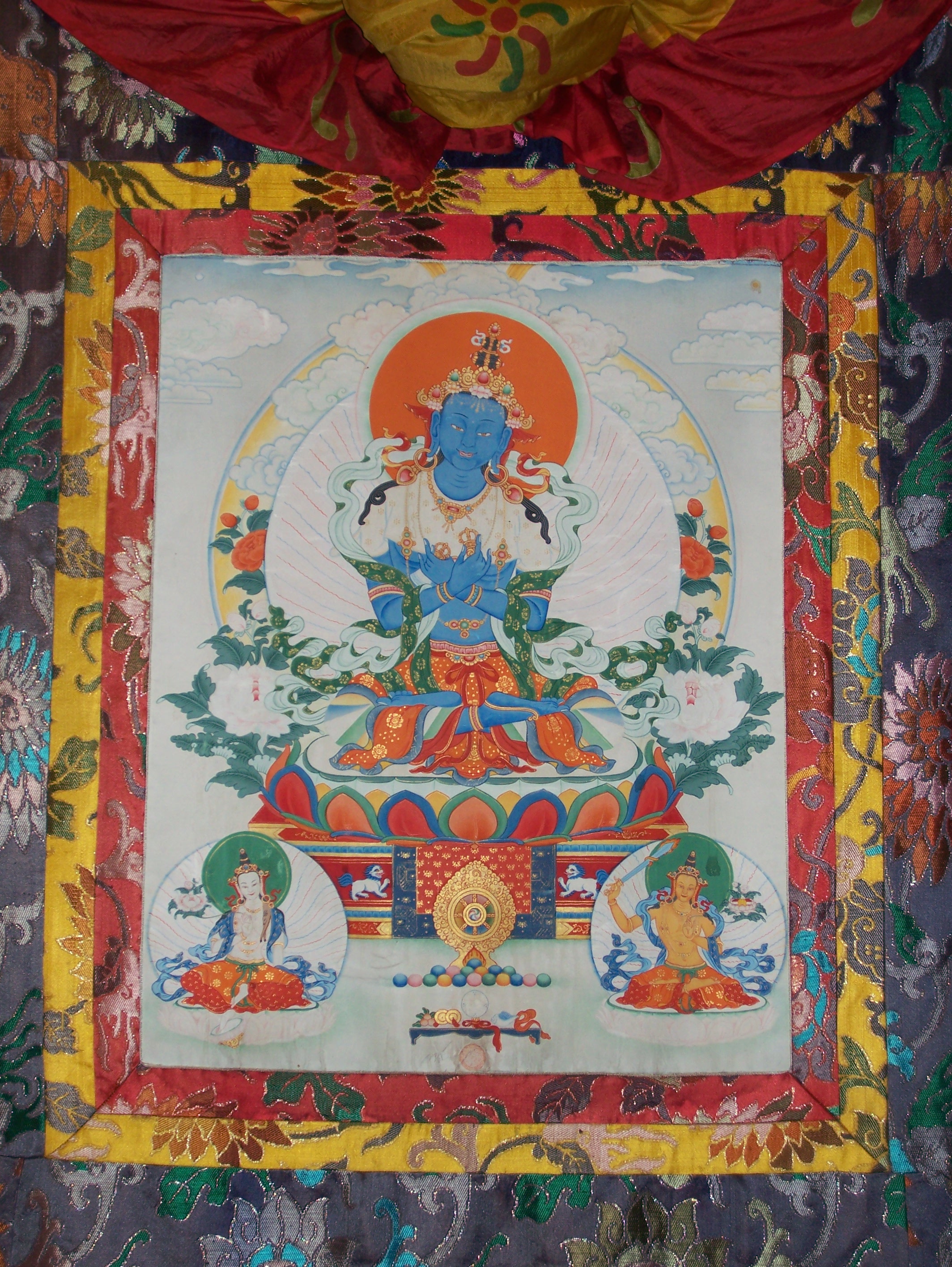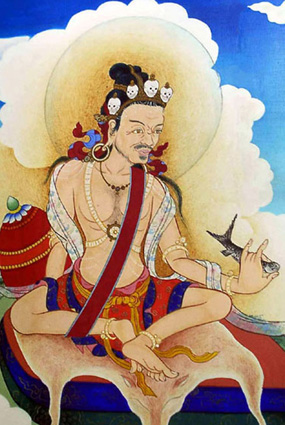|
Taklung Kagyu
The Taklung Kagyu () is a sub-school of the Kagyu school of Tibetan Buddhism. History The Taklung Kagyu lineage was founded by Taklung Thangpa Tashi Pal in 1180 CE. Like the other Sarma schools, it is part of the second founding of Buddhism in Tibet and incorporates the teachings of the early Kadam school. The Taklung Lineage teaches Mahamudra practices in particular. The main seat of Taklung Kagyu is located in the northern part of Tibet in a place called Taklung. In the 13th century, Choejey Sangye Won, the fourth lineage holder, established Riwoche Monastery in Kham. This tradition later came to be known as the Marthang Taklung as distinct from the Lhasa Taklung. Eventually, the Taklung Kagyu school spread throughout Tibet, parts of Mongolia, China and even India. The current lineage holders are the 26th Taklung Shabdrung Rinpoche, the 7th Taklung Ma Rinpoche and the 7th Phakchok Rinpoche. Lineage Marpa Lotsawa brought the Kagyu tradition from India after accomplishing h ... [...More Info...] [...Related Items...] OR: [Wikipedia] [Google] [Baidu] |
Kagyu
The ''Kagyu'' school, also transliterated as ''Kagyü'', or ''Kagyud'' (), which translates to "Oral Lineage" or "Whispered Transmission" school, is one of the main schools (''chos lugs'') of Tibetan (or Himalayan) Buddhism. The Kagyu lineages trace themselves back to the 11th century Indian Mahasiddhas Naropa, Maitripa and the yogini Niguma, via their student Marpa Lotsawa (1012–1097), who brought their teachings to Tibet. Marpa's student Milarepa was also an influential poet and teacher. The Tibetan Kagyu tradition gave rise to a large number of independent sub-schools and lineages. The principal Kagyu lineages existing today as independent schools are those which stem from Milarepa's disciple, Gampopa (1079–1153), a monk who merged the Kagyu lineage with the Kadam tradition. The Kagyu schools which survive as independent institutions are mainly the Karma Kagyu, Drikung Kagyu, Drukpa Lineage and the Taklung Kagyu. The Karma Kagyu school is the largest of the sub-schoo ... [...More Info...] [...Related Items...] OR: [Wikipedia] [Google] [Baidu] |
Taklung Ma Rinpoche
Tenzin Kunzang Jigme Rinpoche, the seventh Taklung Ma Rinpoche, was born in 1977 to Ngawang Tendar and Deden Zangmo. In 1987, the 14th Dalai Lama formally recognized him as the reincarnation of the sixth Taklung Matul Thupten Jigme Choechog Rinpoche. He spent a few years in Namgyal Monastery studying Buddhist philosophy and practice. In 1991 he entered the Institute of Buddhist Dialectics, Dharamsala to learn both the Sutra and Tantra teachings of the Buddha and completed his studies in 2003. Having finished his Buddhist studies, he moved to Manali, Kulu, in Himachal Pradesh. Since there is no monastic seat of the Taklung Kagyu tradition in India, the Taklung Kagyu The Taklung Kagyu () is a sub-school of the Kagyu school of Tibetan Buddhism. History The Taklung Kagyu lineage was founded by Taklung Thangpa Tashi Pal in 1180 CE. Like the other Sarma schools, it is part of the second founding of Buddhism in T ... Rinpoches are jointly working for its establishment. Sources Off ... [...More Info...] [...Related Items...] OR: [Wikipedia] [Google] [Baidu] |
Kadampa
300px, Tibetan Portrait of Atiśa The Kadam school () of Tibetan Buddhism was an 11th century Buddhist tradition founded by the great Bengali master Atiśa (982-1054) and his students like Dromtön (1005–1064), a Tibetan Buddhist lay master.Silk, Jonathan A; von Hinüber, Oskar; Eltschinger, Vincent; Bowring, Richard; Radich, Michael (2015). ''Brill's Encyclopedia of Buddhism: Vol. II Lives'', pp. 1145-1158. Brill. The Kadampa stressed compassion, pure discipline and study.Chokyi Dragpa (2015). ''Illuminating the Thirty-Seven Practices of a Bodhisattva'', Glossary. Simon and Schuster. The most evident teachings of that tradition were the graduated teachings on the Mahayana path. These special presentations became known as lojong (mind training) and lamrim (stages of the path). Kadam masters like Atiśa also promoted the study of madhyamaka philosophy. According to Ronald M. Davidson, "Atiśa's coming to Tibet in 1042 was the threshold moment in the efflorescence of Buddhism ... [...More Info...] [...Related Items...] OR: [Wikipedia] [Google] [Baidu] |
Phagmo Drupa Dorje Gyalpo
Phagmo Drupa Dorje Gyalpo () 110-1170 was one of the three main disciples of Gampopa Sonam Rinchen who established the Dagpo Kagyu school of Tibetan Buddhism; and a disciple of Sachen Kunga Nyingpo 092-1158one of the founders of the Sakya school of Tibetan Buddhism. He was the elder brother of Kathog Dampa Deshek 122-1192 who founded Kathog monastery and the Kathog branch of the Nyingma school. Biographical details In 1158 Dorje Gyalpo built a hermitage at Phagmo Drupa ("Sow's Ferry Crossing") in a juniper forest in Nêdong () above the Tsangpo (Brahmaputra) river valley. Later, as his fame spread and disciples gathered, this site developed into the major monastic seat of Dentsa Thel () which was the center of the Phagmo Drupa or Phagdru Kagyu () school of Tibetan Buddhism, one of the "four great" Dagpo Kagyu schools. The Phagmodrupas After the death of Phagmo Drupa Dorje Gyalpo, his main disciple Jigten Sumgon appointed Chenga Drakpa Jungne as abbot Dentsa Thel. In 1 ... [...More Info...] [...Related Items...] OR: [Wikipedia] [Google] [Baidu] |
Gampopa
Gampopa Sönam Rinchen (, 1079–1153) was the main student of Milarepa, and a Tibetan Buddhist master who codified his own master's ascetic teachings, which form the foundation of the Kagyu educational tradition. Gampopa was also a doctor and tantric master. He authored the first Lamrim text, ''Jewel Ornament of Liberation,'' and founded the Dagpo Kagyu school. He is also known as Dvagpopa, and by the titles ''Dakpo Lharjé'' "the physician from Dakpo" () and ''Daö Zhönnu'', "''Candraprabhakumara''" (). Biography Gampopa was born in the Nyal (or Nyel) district, Central Tibet and from an early age was a student of medicine in the Indian, Chinese and Tibetan medical traditions. Later in his life he moved to the region of Dakpo (''dwags po'') in southern Tibet and hence was also called Dakpopa (''dwags po pa''), the man from Dakpo. The region is also near Gampo Hills, hence his other name, Gampopa. In his youth Gampopa studied under the Nyingma lama Barey as well as under the K ... [...More Info...] [...Related Items...] OR: [Wikipedia] [Google] [Baidu] |
Milarepa
Jetsun Milarepa (, 1028/40–1111/23) was a Tibetan siddha, who was famously known as a murderer when he was a young man, before turning to Buddhism and becoming a highly accomplished Buddhist disciple. He is generally considered one of Tibet's most famous yogis and spiritual poets, whose teachings are known among several schools of Tibetan Buddhism. He was a student of Marpa Lotsawa, and a major figure in the history of the Kagyu school of Tibetan Buddhism. He is also famous for the feat of climbing Mount Kailash. Biography — ''The Life of Milarepa'' Milarepa's life-story is famous in Tibetan culture, and retold many times. The best-known biography, ''The Life of Milarepa'', written by Tsangnyön Heruka (1452–1507) in the fifteenth century and drawing from older biographies, is still very popular. Most of the present-day stories on Milarepa come from this single source, with oral lineage predominating as well as relics including his bearskin coat. While "very little s kno ... [...More Info...] [...Related Items...] OR: [Wikipedia] [Google] [Baidu] |
Vajrayogini
Vajrayoginī ( sa, italic=yes, Vajrayoginī वज्रयोगिनी; , Dorjé Neljorma; mn, Огторгуйд Одогч, Нархажид, ) is a Tantric Buddhist female Buddha and a . The ''Vajrayogini'' cult dates back to the tenth and twelfth centuries. Vajrayoginī's essence is "great passion" (''maharaga''), a transcendent passion that is free of selfishness and illusion—she intensely works for the well-being of others and for the destruction of ego clinging. She is seen as being ideally suited for people with strong passions, providing the way to transform those passions into enlightened virtues. She is an Anuttarayoga Tantra iṣṭadevatā (meditation deity) and her practice includes methods for preventing ordinary death, intermediate state (bardo) and rebirth ( samsara) by transforming them into paths to enlightenment, and for transforming all mundane daily experiences into higher spiritual paths. Practices associated with her are Chöd and the Six Yogas of ... [...More Info...] [...Related Items...] OR: [Wikipedia] [Google] [Baidu] |
Vajradhara
Vajradhara (Sanskrit: वज्रधर. (Also, the name of Indra, because 'Vajra' means diamond, as well as the thunderbolt, anything hard more generally) Tibetan: རྡོ་རྗེ་འཆང། rdo rje 'chang (Dorje Chang); zh, t=金剛總持, p=Jīngāng zǒng chí; Javanese: Kabajradharan; Japanese: 持金剛仏; English: Diamond-holder; Vietnamese: Kim Cang Tổng Trì) is the ultimate primordial Buddha, or Adi-Buddha, according to the Sakya, Gelug and Kagyu schools of Tibetan Buddhism. In the evolution of Indian Buddhism, Buddha Vajradhara gradually displaced Samantabhadra, who is the 'Primordial Buddha' in the Nyingma, or 'Ancient School.' However, the two are metaphysically equivalent. Achieving the 'state of Vajradhara' is synonymous with complete realisation. According to the Kagyu lineage, Buddhā Vajradhara is the primordial Buddha, the Dharmakaya Buddha. He is depicted as dark blue in color, expressing the quintessence of buddhahood itself and representing ... [...More Info...] [...Related Items...] OR: [Wikipedia] [Google] [Baidu] |
Tilopa
Tilopa (Prakrit; Sanskrit: Talika or Tilopadā; 988–1069) was an Indian Buddhist monk in the tantric Kagyu lineage of Tibetan Buddhism. He lived along the Ganges River, with wild ladies as a tantric practitioner and mahasiddha. He practiced Anuttarayoga Tantra, a set of spiritual practices intended to accelerate the process of attaining Buddhahood. He became a holder of all the tantric lineages, possibly the only person in his day to do so. As well as the way of insight, and Mahamudra he learned and passed on the Way of Methods, today known as the 6 Yogas of Naropa, and guru yoga. Naropa is considered his main student. Life Tilopa was born into the priestly caste – according to some sources, a royal family – but he adopted the monastic life upon receiving orders from a dakini (female buddha whose activity is to inspire practitioners) who told him to adopt a mendicant and itinerant existence. From the beginning, she made it clear to Tilopa that his real parents were ... [...More Info...] [...Related Items...] OR: [Wikipedia] [Google] [Baidu] |
Naropa
Nāropā (Prakrit; sa, Nāropāda, Naḍapāda or Abhayakirti) or Abhayakirti was an Indian Buddhist Mahasiddha. He was the disciple of Tilopa and brother, or some sources say partner and pupil, of Niguma. As an Indian Mahasiddha, Naropa's instructions inform Vajrayana, particularly his six yogas of Naropa relevant to the completion stage of anuttarayogatantra. He was also one of the gatekeepers of Vikramashila monastery which is located in Bihar. Although some accounts relate that Naropa was the personal teacher of Marpa Lotsawa, other accounts suggest that Marpa held Naropa's lineage through intermediary disciples only. Names According to scholar John Newman, "the Tibetans give Nāro's name as ''Nā ro pa, Nā ro paṇ chen, Nā ro ta pa,'' and so forth. The manuscript of the ''Paramarthasaṃgraha'' preserves a Sanskrit form ''Naḍapāda'' (''Paramarthasaṃgraha'' 74). A Sanskrit manuscript edited by Tucci preserves an apparent Prakrit form ''Nāropā'', as well as a ... [...More Info...] [...Related Items...] OR: [Wikipedia] [Google] [Baidu] |
Marpa Lotsawa
Marpa Lotsawa, Lotsāwa (, 1012–1097), sometimes known fully as Marpa Chökyi Lodrö (Wylie transliteration, Wylie: mar pa chos kyi blo gros) or commonly as Marpa the Translator (Marpa Lotsāwa), was a Tibetan Buddhism, Tibetan Buddhist teacher credited with the transmission of many Vajrayana teachings from India, including the teachings and lineages of Mahamudra. Due to this the Kagyu lineage, which he founded, is often called Marpa Kagyu in his honour.samye.orgThe Kagyu Lineage: the Tibetan Lineage Masters: Marpa the Translator/ref> Although some accounts relate that the Mahasiddha Naropa was the personal teacher of Marpa, other accounts suggest that Marpa held Naropa's lineage through intermediary disciples only. Either way, Marpa was a personal student of the Mahasiddha Maitripa and of the dakini Niguma. Biography Born as Marpa Chökyi Lodrö, in Lhodrak Chukhyer in the southern part of Tibet, to an affluent family, he began studying at a young age but was wild and untamed ... [...More Info...] [...Related Items...] OR: [Wikipedia] [Google] [Baidu] |







